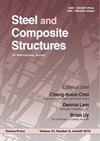A nonlocal Layerwise theory for free vibration analysis of nanobeams with various boundary conditions on Winkler-Pasternak foundation
IF 3.9
3区 工程技术
Q1 CONSTRUCTION & BUILDING TECHNOLOGY
引用次数: 1
Abstract
In this study, a nonlocal Layerwise theory is presented for free vibration analysis of nanobeams resting on an elastic foundation. Eringen's nonlocal elasticity theory is used to consider the small-scale effect on behavior of nanobeam. The governing equations are obtained by employing Hamilton's principle and Layerwise theory of beams and Eringen's nonlocal constitutive equation. The presented theory takes into account the in-plane and transverse normal and shear strain in the modeling of the nanobeam and can predict more accurate results. The governing equations of the beam are solved by Navier's method for Simple-Simple boundary conditions and semi-analytical methods to obtain the natural frequency for various boundary conditions including Clamped-Simple (C-S), Clamped-Clamped (C-C) and Free-Free (F-F) boundary conditions. Predictions of the present theory are compared with benchmark results in the literature. Effects of nonlocal parameter, Pasternak shear coefficient, Winkler spring coefficient, boundary conditions, and the aspect ratio on the free vibration of nanobeams are studied. The flexural mode and thickness mode natural frequencies of the nanobeam are predicted. It is shown that the predictions of present method are more accurate than the equivalent single layer theories. The theoretical developments and formulation presented herein should also be served to analyze the mechanical behavior of various nanostructures with various loading and boundary conditions.温克勒-帕斯捷尔纳克地基上不同边界条件纳米梁自由振动分析的非局部分层理论
本文提出了基于弹性地基的纳米梁自由振动分析的非局部分层理论。采用Eringen的非局部弹性理论研究了纳米梁的小尺度效应。利用哈密顿原理、梁的分层理论和Eringen的非局部本构方程得到了控制方程。该理论在模拟纳米梁时考虑了面内应变和横向法向应变和剪切应变,预测结果更为准确。采用简单-简单边界条件下的Navier法和半解析法求解梁的控制方程,得到了夹紧-简单(C-S)、夹紧-夹紧(C-C)和自由-自由(F-F)边界条件下的固有频率。本理论的预测与文献中的基准结果进行了比较。研究了非局部参数、帕斯捷尔纳克剪切系数、温克勒弹簧系数、边界条件和展弦比对纳米梁自由振动的影响。预测了纳米梁的弯曲模态和厚度模态固有频率。结果表明,与等效的单层理论相比,该方法的预测精度更高。本文提出的理论发展和公式也应用于分析各种纳米结构在各种载荷和边界条件下的力学行为。
本文章由计算机程序翻译,如有差异,请以英文原文为准。
求助全文
约1分钟内获得全文
求助全文
来源期刊

Steel and Composite Structures
工程技术-材料科学:复合
CiteScore
8.50
自引率
19.60%
发文量
0
审稿时长
7.5 months
期刊介绍:
Steel & Composite Structures, An International Journal, provides and excellent publication channel which reports the up-to-date research developments in the steel structures and steel-concrete composite structures, and FRP plated structures from the international steel community. The research results reported in this journal address all the aspects of theoretical and experimental research, including Buckling/Stability, Fatigue/Fracture, Fire Performance, Connections, Frames/Bridges, Plates/Shells, Composite Structural Components, Hybrid Structures, Fabrication/Maintenance, Design Codes, Dynamics/Vibrations, Nonferrous Metal Structures, Non-metalic plates, Analytical Methods.
The Journal specially wishes to bridge the gap between the theoretical developments and practical applications for the benefits of both academic researchers and practicing engineers. In this light, contributions from the practicing engineers are especially welcome.
 求助内容:
求助内容: 应助结果提醒方式:
应助结果提醒方式:


